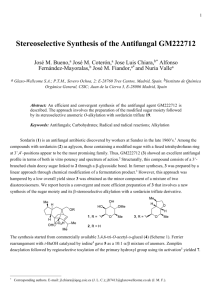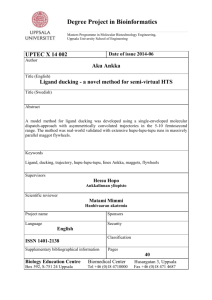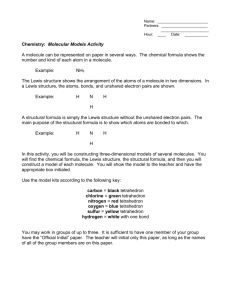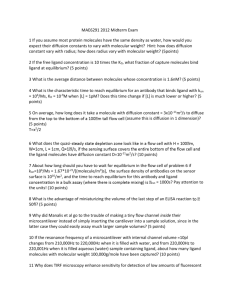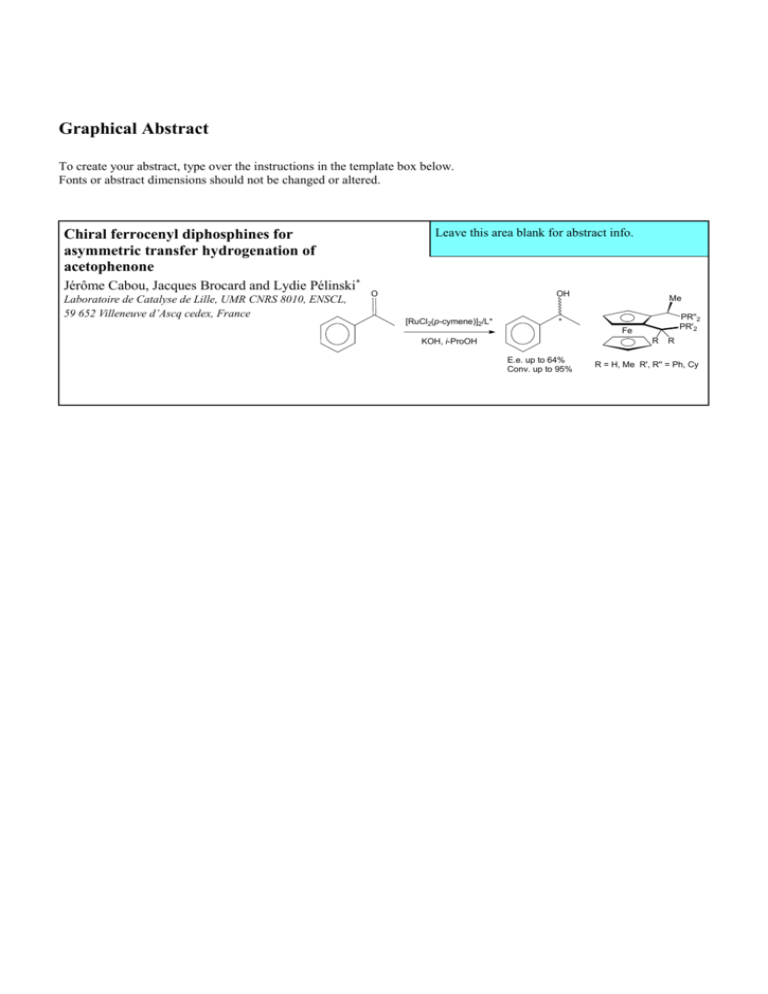
Graphical Abstract
To create your abstract, type over the instructions in the template box below.
Fonts or abstract dimensions should not be changed or altered.
Leave this area blank for abstract info.
Chiral ferrocenyl diphosphines for
asymmetric transfer hydrogenation of
acetophenone
Jérôme Cabou, Jacques Brocard and Lydie Pélinski*
Laboratoire de Catalyse de Lille, UMR CNRS 8010, ENSCL,
59 652 Villeneuve d’Ascq cedex, France
OH
O
[RuCl2(p-cymene)]2/L*
Me
PR''2
PR'2
*
Fe
R
KOH, i-ProOH
E.e. up to 64%
Conv. up to 95%
R
R = H, Me R', R'' = Ph, Cy
Tetrahedron Letters
1
TETRAHEDRON
LETTERS
Pergamon
Chiral Ferrocenyl Diphosphines for Asymmetric Transfer
Hydrogenation of Acetophenone
Jérôme Cabou, Jacques Brocard and Lydie Pélinski*
Laboratoire de Catalyse de Lille, Catalyse Asymétrique et Polymérisation,
UMR CNRS 8010, ENSCL,59 652 Villeneuve d’Ascq cedex, France
Abstract— The synthesis of new optically pure ferrocenyl diphosphines have been realized from (R)-(+)-N,Ndimethylaminoethylferrocene. Particularly, dissymmetric ferrocenyl diphosphines have been synthesized. The diphosphines have been used
as ligands in asymmetric transfer hydrogenation of acetophenone in the presence of Ru catalysts. © 2016 Elsevier Science. All rights
reserved
Catalytic asymmetric hydrogenation of prochiral ketones to
chiral alcohols using transition metal complexes has gained
increasing interest during recent years.1 In particular,
ruthenium-catalyzed asymmetric transfer hydrogenation
using 2-propanol under basic conditions presents the
advantages of a low cost, ease of handling and high
solubility of 2-propanol as hydrogen donor reagent.2
Noyori developed an efficient and highly enantioselective
ruthenium catalyst using diamines as chiral ligands.3 Other
types
of
ligands
such
as
amino
alcohols,4
aminooxazolines,5 aminophosphines,6 diureas,7 and
phosphine oxides8 have also been used with various levels
of rates, yields and selectivities. In particular, only
ferrocenyl ligands possessing oxazoline/phosphines,9
triphosphines,10 amino alcohols11 imine/phosphines,12 and
diamines13 have been studied. Also, to our best knowledge,
the involvement of ferrocenyl diphosphines has not been
reported so far. Moreover, Genêt reported a series of
dibromodiphosphinoruthenium catalysts
([RuP*2Br2],
where P*=diphosphine) for transfer hydrogenation of
ketones, achieving good conversion in short reaction
times.14 However, only moderate enantioselectivities (7–
52% ee) has been obtained.
We have had an ongoing interest in the synthesis and use of
optically active ligands in asymmetric catalysis, especially
ferrocenyl amino alcohols.15 Herein we present the
synthesis of new ferrocenyl diphosphines 1-5 (Figure 1)
and the first results for asymmetric transfer hydrogenation
of acetophenone catalyzed by Ru(II) complexes of these
bidentate ligand system. Our initial efforts focused on
screening a variety of ferrocenyl compounds in which
chelating groups and stereogenic centers were varied in
order to ascertain their effects on the reaction.
Me
PR''2
PR'2
Fe
R
PPh2
PCy2
R
R = H, R' = R'' = Ph
R = H, R' = R'' = Cy
R = H, R' = Ph, R'' = Cy
R = Me, R' = R'' = Ph
1
2
3
4
5
Figure 1.
Following a similar procedure as described by Fukuzawa, 16
the ferrocenyl diphosphines 1 and 2 have been synthesized
from (R)-N,N-dimethyl-1-ferrocenylethyl amine 6 (Scheme
1).17 Thus, the commercial ferrocenyl amine 6 has been
converted to the amino alcohol 7 in two steps in a global
yield of 88%. The ortholithiation of 6 by t-BuLi followed
by addition of DMF and the reduction by NaBH4 of the
aldehyde led to 7. The acylation of the alcohol group was
carried out in acetic anhydride in the presence of
dimethylaminopyridine and triethylamine at room
temperature to give 8 in 95% yield. The dimethylamino
group was then substituted by an acetoxy residue in the
———
*
Fe
Corresponding author. Tel.: +33-3-20434893; fax: +33-3-20436585; e-mail: lydie.pelinski@ensc-lille.fr.
1
Tetrahedron Letters
Me
Me
NMe2
NMe2
OH
a,b
Fe
Fe
Fe
8 : 95%
Me
Fe
OAc
OAc
Me
e,f
NMe2
OAc
c
7 : 88%
6
d
Me
Me
BH3
PR2
PR2
Fe
g
PR2
PR2
Fe
BH3
9 : 72%
R = Ph
R = Cy
10 : 81%
11 : 84%
R = Ph 1 : 80%
R = Cy 2 : 50%
Scheme 1 Reagents and conditions: a) t-Buli, Et2O then DMF; b) NaBH4, MeOH; c) Ac2O, DMAP, NEt3, RT, 1 h; d) Ac2O, 100°C, 45 min;
e) HBF4, CH2Cl2 then HPR2, CH2Cl2, RT; f) BH3.Me2S, THF, RT, 1 h; g) Morpholine for 1 or HBF4.OEt2, RT for 2, 12h.
presence of acetic anhydride at 100°C providing 9 in 72%
yield. The diacetoxyferrocene 9 was then converted into
diphosphines in the presence of HBF4 followed by addition
of HPR2 in CH2Cl2 at room temperature. A protection of
the diphosphines was necessary for a purification by silica
gel column chromatography. Ferrocenyl protected
diphosphines 10 and 11 were obtained in 81 and 84%
global yield respectively. The deprotection of the
diphosphines by morpholine or HBF4.OEt2 yielding
respectively 1 and 2 was carried out just before use in
catalysis.
The synthesis of the ferrocenyl diphosphine 318 was carried
out from the amino alcohol 7 (Scheme 2). Thus, the alcohol
function was first transformed to diphenylphosphine group
in the presence of HBF4 following by addition of HPPh2 at
room temperature providing to aminophosphine 12. After
substitution of dimethylamino group by PCy2 and
protection by BH3, the protected diphosphine 13 was
obtained in 65% global yield for the three steps. The
deprotection of the diphosphine by HBF4.OEt2 led to 3 in
73% yield.
According to the literature method,19 the optically pure
amino alcohol 14, possessing only planar chirality, has
been synthesized from N,N-dimethylaminomethylferro
cene. Then, the analogous reactions as described previously
for 3, have been realized from ferrocenyl compound 14
(Scheme 2). The protected diphosphine 16 has been
obtained in 59% global yield. The deprotection by
HBF4.OEt2 of 16 leads to 5 in 50% yield.20
R
R
NMe2
OH
Fe
a
NMe2
PPh2
Fe
R = Me 7
14
R=H
R = Me 12
15
R=H
R
b,c
Fe
R
BH3
PCy2
PPh2
d
Fe
PCy2
PPh2
BH3
R = Me 13: 65%
16: 59%
R=H
R = Me 3: 73%
5: 50%
R=H
Scheme 2 Reagents and conditions: a) HBF4, CH2Cl2 then HPPh2,
CH2Cl2; b) HPCy2, AcOH, for R = Me, 90°C, 1.45 h and for R = H,
120°C, 3 h; c) BH3.Me2S, THF, RT, 1 h; d) HBF4.OEt2, RT, 12h.
The ferrocenyl diphosphines 4 has been synthesized from
(R)-N,N-dimethyl-1-ferrocenylethylamine 6 (Scheme 3).21
Thus, the ortholithiation of 6 by t-BuLi followed by
addition of diethylcarbonate led to 17 in 81% yield. The
dimethylamino group was then substituted by an acetoxy
residu in the presence of acetic anhydride at 100°C
providing 18 in 80% yield. The ferrocenyl dialcohol 19 was
obtained quantitatively by the addition of an excess of
MeLi on 18. The dialcohol was then converted into
diphosphine 4 in the presence of HBF4 followed by
addition of HPPh2 in CH2Cl2 at room temperature. The
diphosphine 4 has been obtained in 36% yield.
In order to examine the catalytic behavior of these new
ferrocenyl ligands, transfer hydrogenation of acetophenone,
using [RuCl2(p-cymene)]2 and i-PrOH/KOH mixture as the
base, has been first investigated (Scheme 4).22 The
preliminary results are summarized in Table 1.
Tetrahedron Letters
Me
1
Me
Me
NMe2
NMe2
a
Fe
OAc
b
CO2Et
Fe
Fe
18 : 80%
17 : 81%
6
Me
c
OH
OH
Fe
CO2Et
Me
d
PPh2
PPh2
Fe
Me Me
Me Me
4 : 36%
19 : 99%
Scheme 3 Reagents and conditions: a) t-Buli, Et2O then CO(OEt)2; b) Ac2O, 100°C, 1 h; c) MeLi (6 eq); d) HBF4, CH2Cl2 then HPPh2, CH2Cl2, RT
OH
O
[RuCl2(p-cymene)]2/L*
*
KOH, i-ProOH
Scheme 4
Table 1. Asymmetric transfer hydrogenation of acetophenone in the
presence of ligands 1-5a
Entry
L*
Time
Conversion b
min
%
Eec %
Config.d
1
1
10
30
61
R
2
1
50
60
55
R
3e
1
2
95
40
R
4f
1
10
51
64
R
g
5
2
60
66
19
S
6
3
12
41
20
S
7
4
130
71
50
R
8
5
270
5
29
S
The reversibility of the asymmetric transfer hydrogenation
of ketones to secondary alcohols with 2-propanol
frequently deteriorates the enantiomeric purity of the chiral
products. Indeed, a decrease of enantiomeric excess was
observed during the reaction time in presence of ligand 1.
61% ee was obtained after 10 min and 55% ee after 50 min
(entries 1 and 2).
Performing the hydrogenation at 80°C led to a decrease of
the enantioselectivity and an increase of activity providing
1-phenylethanol with 40% ee and 95% yield after only 2
min (entry 3).
The enantioselectivity was practically unaffected by
changing the ratio ligand/Ru from 2 to 1 (compare entries 2
and 4).
It appears that the presence of the diphenyl group in the
ligand is essential for a good enantioselectivity.
Replacement of the diphenyl by a dicyclohexyl group on
the phosphorus atom led to a reduction of the
enantioselectivity and inverted the sense of the induction.
As such, (S) 1-phenylethanol was obtained in 19% of ee in
the presence of ligand 2 (entry 5). This value corresponds
to the maximal enantiomeric excess at 60 min.
a
Reactions were carried out by using 2 mmol of acetophenone in the
presence of [Ru(p-cymene)Cl2]2 (substrate/Ru = 100), the ligand
(ligand/Ru = 2) and KOH (0.1 mmol). For details see reference 16.
b
The progression of the reaction was monitored by GC analysis with a
Chiraldex capillary column.
In ligand 4, the replacement of the hydrogen atom on the
lateral chain by two methyl groups induced a diminution of
enantioselectvity (compare entries 1 and 7, 61% ee for 1 vs
50% ee for 4).
c
. Determined by GC analysis with a Chiraldex capillary column.
d
. Absolute configurations were determined by comparing the sign of the
optical rotations with the literature ones.
e
. Reaction performed at 80°C.
f
. Reaction performed in using ligand/Ru = 1.
g
. Maximal e.e.
The first catalytic system investigated was carried out in
the presence of ligand 1, presenting carbon centered and
planar chiralities. As shown in Table 1, a modest
enantioselectivity (61% ee, entry 1) was observed in
presence of ferrocenyl diphosphine 1. Moreover, only 30%
of conversion was obtained after 10 min.
It also seems that, for this type of ligand, the presence of a
chiral center adjacent to the diphosphino group has a major
influence on the catalytic activity. Thus, a low activity (5%
after 270 min, entry 8) has been obtained in the presence of
the ferrocenyl diphosphine 5, possessing only planar
chirality.
In summary, this paper describes the synthesis of a series
of new ferrocenyl diphosphines and their use as ligands for
asymmetric transfer hydrogenation of acetophenone
catalyzed by Ru(II) complexes. The results obtained for the
ligand 1 represents the best one from the literature with this
type of catalytic system using ferrocenyl diphosphines as
2
Tetrahedron Letters
ligands. The improvement of the ligand design is under
study.
19.
20.
Acknowledgments
The authors gratefully thank the “Ministère de la Recherche et de
la Technologie” ands the “Centre National de la Recherche
Scientifique” for financial support and Francine AgbossouNiedercorn and Isabelle Suisse for helpfull discussions.
21.
22.
References
1.
2.
3.
4.
5.
6.
7.
8.
9.
10.
11.
12.
13.
14.
15.
16.
17.
18.
(a) Noyori, R. Asymmetric Catalysis in Organic
Synthesis; John Wiley: New York, 1994. (b) Catalytic
Asymmetric Synthesis; Ojima, I., Ed.; VCH: New-York,
2000.
(a) Zassinovitch, G.; Maestroni, G.; Gladiali, S. Chem
Rev. 1992, 92, 1051. (b) Palmer, M. J.; Wills, M.
Tetrahedron: Asymmetry, 1999, 10, 2045.
(a) Noyori, R.; Hashiguchi, S. Acc. Chem. Res. 1997, 30,
97. (b) Haak, K. J.; Hashiguchi, S.; Fujii, A.; Ikariya, T.;
Noyori, R. Angew. Chem., Int. Ed. Engl. 1997, 36, 285.
(a) Alonso, D. A.; Nordin, S. J. M.; Roth, P.; Tarnai, T.;
Andersson, P. G.; Thommen, M.; Pittelkow, U. J. Org.
Chem. 2000, 65, 3116. (b) Palmer, M. J.; Walsgrove, T.;
Wills, M. J. Org Chem. 1997, 62, 5226.
Jiang, Y.; Jiang, Q.; Zhang, X. J. Am. Chem. Soc. 1998,
120, 3817.
(a) Léautey, M.; Jubault, P.; Pannecoucke, X.; Quirion,
J.-C. Eur. J. Org. Chem. 2003, 3761. (b) Gao, J.-X.;
Ikariya, T.; Noyori, R. Organometallics 1996, 15, 1087.
Gamez, P.; Dunjic, B.; Lemaire, M. J. Org. Chem. 1996,
61, 5196.
Maj, A. M.; Pietrusiewicz, K. M.; Suisse, I.; Agbossou,
F.; Mortreux, A. Tetrahedron: Asymmetry 1999, 10, 831.
Sammakia, T.; Stangeland, E. L. J. Org. Chem. 1997, 62,
6104.
Barbaro, P.; Bianchini, C.; Togni, A. Organometallics
1997, 16, 3004.
Patti, A.; Pedotti, S. Tetrahedron: Asymmetry 2003, 14,
597.
Dai, H.; Hu, X.; Chen, H.; Bai, C.; Zheng, Z.
Tetrahedron: Asymmetry 2003, 14, 1467.
Schwink, L.; Ireland, T.; Püntener, K.; Knochel, P.
Tetrahedron: Asymmetry 1998, 9, 1143.
Genêt, J.-P.; Ratovelomanana-Vidal, V.; Pinel, C. Synlett
1993, 7, 478.
Bastin, S.; Ginj, M.; Brocard, J.; Pélinski, L.;
Nowogrocki, G. Tetrahedron: Asymmetry 2003, 14,
1701.
Fukuzawa, S.-I.; Tsuchiya, D.; Sasamoto, K.; Hiramo,
K.; Ohtaguchi, M. Eur. J. Org. Chem. 2000, 2877.
1: 1H NMR (CDCl3) 7.5-7.0 (m, 20H), 4.1 (s, 5H), 4.0
(m, 1H), 3.9 (m, 1H), 3.8 (m, 1H), 3.3 (m, 1H), 2.6 (d, J
= 15.5 Hz, 1H), 2.0 (dd, J = 15.5 and 4.2 Hz, 1H), 1.5
(dd, J = 7.1 and 13.9 Hz, 3H).31P NMR (CDCl3) 5.8, 18.2.
2: 1H NMR (CDCl3) 4.3 (m, 1H), 4.1 (s, 5H), 4.0 (m,
1H), 3.9 (m, 1H), 2.8 (m, 1H), 2.6-2.4 (m, 2H), 2.0-1.0
(m, 47H). 31P NMR (CDCl3) 12.2, 7.9.
3: 1H NMR (CDCl3) 7.5-7.2 (m, 10H), 4.0 (s, 5H), 4.0
(m, 1H), 3.9 (m, 2H), 3.4 (m, 1H), 3.1 (m, 1H), 2.9 (m,
1H), 1.9-1.0 (m, 25H). 31P NMR (CDCl3) 12.0, -17.5.
Nicolosi, G.; Patti, A.; Morrone, R.; Piattelli, M.
Tetrahedron: Asymmetry 1994, 5, 1275.
5: 1H NMR (CDCl3) 7.5-7.2 (m, 10H), 4.1 (m, 1H),
4.0 (s, 5H), 3.8 (m, 1H), 3.7 (m, 1H), 3.2 (d, J = 14.4
Hz, 1H), 3.1 (d, J = 14.4 Hz, 1H), 2.5 (dd, J = 15.2 and
1.7 Hz, 1H), 2.3 (dd, J = 15.2 and 1.7 Hz, 1H), 1.8-1.1
(m, 22H). 31P NMR (CDCl3) -5.1, -16.0.
4: 1H NMR (CDCl3) 7.7-6.9 (m, 20H), 4.1 (s, 5H), 4.1
(m, 1H), 4.0 (m, 1H), 3.9 (m, 1H), 3.2 (m, 1H), 1.6 (d, J
= 14.2 Hz, 3H), 1.5 (m, 3H), 1.4 (d, J = 3.4 Hz, 3H). 31P
NMR (CDCl3) 12.9, 6.8.
Typical experimental procedure: the appropriate amount
of ligand (0.02 mmol) was added to the catalyst
precursor (0.01 mmol) [Ru(p-cymene)Cl2]2 in dry
freshly distilled 2-propanol (5 mL) and stirred at 80°C
for 20 min under nitrogen. After allowing the orange
solution to cool to room temperature, a solution of
acetophenone (2 mmol) in 2-propanol (14 mL) and KOH
(1 mL, 0.1 M in 2-propanol) was added. The resulting
solution was stirred at 20°C and the reaction was
monitored by GC.

